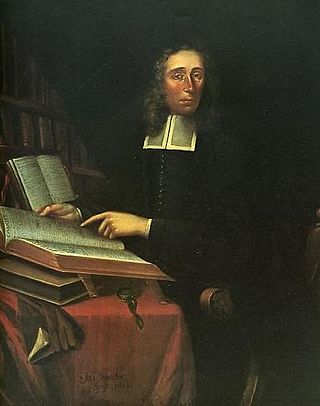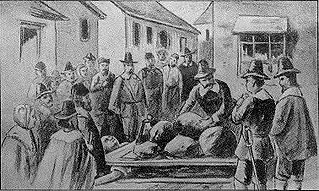
The Salem witch trials were a series of hearings and prosecutions of people accused of witchcraft in colonial Massachusetts between February 1692 and May 1693. More than 200 people were accused. Thirty people were found guilty, nineteen of whom were executed by hanging. One other man, Giles Corey, died under torture after refusing to enter a plea, and at least five people died in jail.

Increase Mather was a New England Puritan clergyman in the Massachusetts Bay Colony and president of Harvard College for twenty years (1681–1701). He was influential in the administration of the colony during a time that coincided with the notorious Salem witch trials.
Abigail Williams was an 11- or 12-year-old girl who, along with nine-year-old Betty Parris, was among the first of the children to falsely accuse their neighbors of witchcraft in 1692; these accusations eventually led to the Salem witch trials.
John Proctor was a landowner in the Massachusetts Bay Colony. He and his wife Elizabeth were tried and convicted of witchcraft as part of the Salem Witch Trials, whereupon he was hanged.

Giles Corey was an English farmer, petty thief, and tried murderer who was accused of witchcraft along with his wife Martha Corey during the Salem witch trials. After being arrested, Corey refused to enter a guilty or not guilty plea. He was subjected to pressing in an effort to force him to plead and died after three days of this torture. Because Corey refused to enter a plea, his estate passed on to his sons instead of being seized by the local government.
Elizabeth Proctor was convicted of witchcraft in the Salem Witch Trials of 1692. She was the wife of John Proctor, who was convicted and executed.

Tituba was an enslaved Native American woman who was one of the first to be accused of witchcraft during the Salem witch trials of 1692–1693.

Bridget Bishop was the first person executed for witchcraft during the Salem witch trials in 1692. Nineteen were hanged, and one, Giles Corey, was pressed to death. Altogether, about 200 people were tried.

George Burroughs was a non-ordained Puritan preacher who was the only minister executed for witchcraft during the course of the Salem witch trials. He is remembered especially for reciting the Lord's Prayer during his execution, something it was believed a witch could never do.

Sarah Good was one of the first three women to be accused of witchcraft in the Salem witch trials, which occurred in 1692 in colonial Massachusetts.

Martha Corey was accused and convicted of witchcraft during the Salem witch trials, on September 9, 1692, and was hanged on September 22, 1692. Her second husband, Giles Corey, was also accused and killed.
Rev. Francis Dane was an English minister who was active in Andover, Massachusetts in the latter half of the 17th century. He was baptized in Bishop's Stortford, England, where it is possible he was also born. He is notable in the history of Colonial America for publicly opposing and consequently entangling his family in the Salem witch trials that took place in Massachusetts beginning in 1692.

Mercy Lewis was an accuser during the Salem Witch Trials. She was born in Falmouth, Maine. Mercy Lewis, formally known as Mercy Allen, was the child of Philip Lewis and Mary (Cass) Lewis.

Jonathan Corwin was a New England merchant, politician, and magistrate. He is best known as one of the judges involved in the Salem witch trials of 1692, although his later work also included service as an associate justice of the Massachusetts Superior Court of Judicature, the highest court of the Province of Massachusetts Bay.

Cultural depictions of the Salem witch trials abound in art, literature and popular media in the United States, from the early 19th century to the present day. The literary and dramatic depictions are discussed in Marion Gibson's Witchcraft Myths in American Culture and see also Bernard Rosenthal's Salem Story: Reading the Witch Trials of 1692
George Jacobs Sr. (1609–1692) was an English colonist in the Massachusetts Bay Colony who was accused of witchcraft in 1692 during the Salem witch trials in Salem Village, Massachusetts. He was convicted and hanged on August 19, 1692. His son, George Jr., was also accused but evaded arrest. Jacobs' accusers included his daughter-in-law and granddaughter, Margaret.
Rev. Nicholas Noyes II was a colonial minister during the time of the Salem witch trials. He was the second minister, called the "Teacher", to Rev. John Higginson. During the Salem witch trials, Rev. Noyes served as the official minister of the trials.
Mary Black was an African-American enslaved by Nathaniel Putnam of the Putnam family who was accused of witchcraft during the Salem witch trials. Nathaniel's nephew was Thomas Putnam, one of the primary accusers. However, Nathaniel himself was skeptical and even defended Rebecca Nurse. Mary was arrested, indicted, and imprisoned, but did not go to trial, and was released by proclamation on January 21, 1693 [O.S. January 11, 1692]. She returned to Nathaniel's household after she was released, another indication of Nathaniel's view of the charges against her.
Sarah Morey was a survivor of the Salem witch trials from Beverly, Massachusetts. She was the daughter of Peter Morey and Mary Morey.










